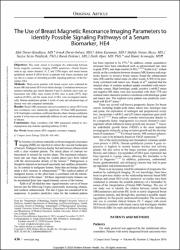| dc.contributor.author | Durur Karakaya, Afak | |
| dc.contributor.author | Durur Subaşı, Irmak | |
| dc.contributor.author | Karaman, Adem | |
| dc.contributor.author | Akçay, Mufide Nuran | |
| dc.contributor.author | Palabıyık, Şaziye Sezin | |
| dc.contributor.author | Erdemci, Burak | |
| dc.contributor.author | Alper, Fatih | |
| dc.contributor.author | Acemoğlu, Hamit | |
| dc.date.accessioned | 10.07.201910:49:13 | |
| dc.date.accessioned | 2019-07-10T19:57:46Z | |
| dc.date.available | 10.07.201910:49:13 | |
| dc.date.available | 2019-07-10T19:57:46Z | |
| dc.date.issued | 2016 | en_US |
| dc.identifier.citation | Durur Karakaya, A., Durur Subaşı, I., Karaman, A., Akçay, M. N., Palabıyık, Ş. S., Erdemci, B. ... Acemoğlu, H. (2016). The use of breast magnetic resonance imaging parameters to identify possible signaling pathways of a serum biomarker, HE4. Journal Of Computer Assisted Tomography, 40(3), 436-441. https://dx.doi.org/10.1097/RCT.0000000000000390 | en_US |
| dc.identifier.issn | 0363-8715 | |
| dc.identifier.issn | 1532-3145 | |
| dc.identifier.uri | https://dx.doi.org/10.1097/RCT.0000000000000390 | |
| dc.identifier.uri | https://hdl.handle.net/20.500.12511/3046 | |
| dc.description | WOS: 000376906600019 | en_US |
| dc.description | PubMed ID: 27192502 | en_US |
| dc.description.abstract | Objectives: This study aimed to investigate the relationship between breast magnetic resonance imaging (MRI) parameters; clinical features such as age, tumor diameter, N, T, and TNM stages; and serum human epididymis protein 4 (HE4) levels in patients with breast carcinoma and use this as a means of estimating possible signaling pathways of the biomarker, HE4. Methods: Thirty-seven patients with breast cancer were evaluated by breast MRI and serum HE4 levels before therapy. Correlations between parameters including age, tumor diameter T and N, dynamic curve type, enhancement ratio (ER), slope wash in (S-WI), time to peak (TTP), slope washout (S-WO), and the serum level of HE4 were investigated statistically. Human epididymis protein 4 levels of early and advanced stage of disease were also compared statistically. Results: Breast MRI parameters showed correlation to serum HE4 levels and correlations were statistically significant. Of these MRI parameters, S-WI had higher correlation coefficient than the others. Human epididymis protein 4 levels were not statistically different in early and advanced stage of disease. Conclusions: High correlation with MRI parameters related to neo-angiogenesis may indicate signaling pathway of HE4. | en_US |
| dc.language.iso | eng | en_US |
| dc.publisher | Lippincott Williams & Wilkins | en_US |
| dc.rights | info:eu-repo/semantics/openAccess | en_US |
| dc.subject | Breast Cancer | en_US |
| dc.subject | HE4 | en_US |
| dc.subject | Magnetic Resonance Imaging | en_US |
| dc.title | The use of breast magnetic resonance imaging parameters to identify possible signaling pathways of a serum biomarker, HE4 | en_US |
| dc.type | article | en_US |
| dc.relation.ispartof | Journal Of Computer Assisted Tomography | en_US |
| dc.department | İstanbul Medipol Üniversitesi, Tıp Fakültesi, Dahili Tıp Bilimleri Bölümü, Radyoloji Ana Bilim Dalı | en_US |
| dc.identifier.volume | 40 | en_US |
| dc.identifier.issue | 3 | en_US |
| dc.identifier.startpage | 436 | en_US |
| dc.identifier.endpage | 441 | en_US |
| dc.relation.publicationcategory | Makale - Uluslararası Hakemli Dergi - Kurum Öğretim Elemanı | en_US |
| dc.identifier.doi | 10.1097/RCT.0000000000000390 | en_US |
| dc.identifier.wosquality | Q4 | en_US |
| dc.identifier.scopusquality | Q2 | en_US |


















